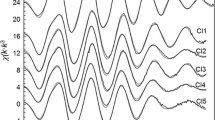Abstract
The yields of nitric oxide from 1 mM and 10 mM sodium dithionite in 5 or 150 mM solutions of HEPES buffer (pH 7.4) differed by a factor of 200. Dithionite acted as both a strong reducing agent and an agent responsible for local acidification of the solutions without significant changes in pH. The concentration of nitric oxide was estimated by electron paramagnetic resonance (EPR) by monitoring its incorporation into water-soluble complexes of Fe with N-methyl-D-glucamine dithiocarbamate (MGD), which resulted in the formation of EPR-detectable mononitrosyl complexes of iron. Ten seconds after dithionite addition, the concentration of mononitrosyl iron complexes reached 2 μM, whereas it did not become greater than 0.01 μM in 5 mM HEPES buffer. It has been suggested that this difference results from a longer lifetime of a localized decrease in pH in a weaker buffer solution. This time could be long enough for the protonation of some nitrite molecules. Nitrous acid thus formed decomposed to nitric oxide. A difference in nitric oxide formation from nitrite in weak and strong buffer solutions was also observed in the presence of hemoglobin (0.3 mM) or serum albumin (0.5 mM). However, in the weak buffer the nitric oxide yield was only three-four times greater than in the strong buffer. An increase in the nitric oxide yield from nitrite was observed in solutions containing both proteins. A significant amount of nitric oxide from nitrite was formed in mouse liver preparation subjected to freezing and thawing procedure followed by slurrying in 150 mM HEPES buffer (pH 7.4) and dithionite addition (10 mM). We suggest that the presence of zones with lowered pH values in cells and tissues may be responsible for the predominance of the acidic mechanism of nitric oxide formation from nitrite. The contribution of nitric oxide formation from nitrite catalyzed by heme-containing proteins as nitrite reductases may be minor under these conditions.
Similar content being viewed by others
References
J. Haldane, R. G. Makgill, and A. E. Mavrogordato, J. Physiol. 21, 160 (1897).
J. Brooks, Proc. R. Soc. Lond., Ser. B 32, 368 (1937).
W. Marshall and C. R. Marshall, J. Biol. Chem. 158, 187 (1945).
F. Jung and H. Remmer, Arch. Exp. Pathol. Pharm. 206, 456 (1949).
K. Sancier, G. Freeman, and J. Mills, Science 137, 752 (1962).
H. Rein, O. Ristau, and G. Yung, Folia Haematol. 82, 191 (1964).
Ya. I. Aghina, L. N. Kayushin, and E. I. Nikishin, Biofizika 11, 710 (1966).
A. F. Vanin and A.G. Chetverikov, Biofizika 13, 608 (1968).
R. Kruszyna, M. Kruszyna, R. P. Smith, et al., J. Pharmacol. Exp. Ther. 241, 307 (1987).
Y. Henry, M. Lepoivre, J. C. Drapier, et al., FASEB J. 7, 1124 (1993).
K. Tsuchiya, Y. Kanematsu, M. Yoshizumi, et al., Am. J. Physiol. 288, H2163 (2005).
R. Ferrari, A. Gargoni, P. Bernocchi, et al., Circulation 94, 2587 (1996).
S. A. Gabel, H. R. Cross, R. E. London, et al., J. Physiol. 273, H2257 (1997).
M. P. Doyle, R.A. Pickering, T. M. DeWeert, et al., J. Biol. Chem. 256, 12393 (1982).
V. P. Reutov, E.G. Sorokina and L.P. Kayushin, Vopr. Med. Khim. 40, 31 (1994).
V. P. Reutov and E.G. Sorokina, Biokhimiya 63, 874 (1998).
K. Huang, A. Keszler, N. Patel, et al., J. Biol. Chem. 280, 31126 (2005).
K. Cosby, K. S. Partovi, J. H. Crawford, et al., Nature Med. 9, 1498 (2003).
E. Nagababu, S. Ramasamy, D. R. Abernethy, and J. M. Rifkind, J. Biol. Chem. 278, 46349 (2003).
M. T. Gladwin, Am. J. Respir. Cell Mol. Biol. 32, 363 (2005).
T. Ohnishi, Methods Mol. Biol. 100, 129 (1998).
S. Shinobu, S. Jones and M. Jones, Acta Pharm. Toxicol. 54 189 (1984).
A. F. Vanin, I. V. Malenkova, and V. A. Serezhenkov, Nitric Oxide: Biol. Chem. 3, 191 (1997).
A. F. Vanin, X. Liu, A. Samouilov, et al., Biochim. Biophys. Acta 1474, 365 (2000).
A. F. Vanin and A, L. Klesvchyov, in Nitric Oxide in Transplant Rejection and Anti-Tumor Defense, Ed. by S. Lukiewicz and J.L. Zweier (Kluwer, 1998), pp. 49–82.
J. M. Robinson and J. R. Lancaster, Am. J. Respir. Cell Mol. Biol. 32, 257 (2005).
N. Nasri, Y. Wang, B. H. Huynh, et al., J. Am. Chem. Soc. 113, 717 (1991).
I. Wasser, S. de Vries, P. Loccoz, et al., Chem. Rev. 102, 1201 (2002).
A. Slama-Schwok, A. Vanin, P. Martasek, et al., Nitric Oxide: Biol. Chem. 14, 157 (2006).
Author information
Authors and Affiliations
Additional information
Original Russian Text © V.D. Mikoyan, L.N. Kubrina, G.N. Khachatryan, A.F. Vanin, 2006, published in Biofizika, 2006, Vol. 51, No. 6, pp. 968–975.
Rights and permissions
About this article
Cite this article
Mikoyan, V.D., Kubrina, L.N., Khachatryan, G.N. et al. Nitrite protonation as a necessary stage in the generation of nitric oxide from nitrite in biological systems. BIOPHYSICS 51, 853–859 (2006). https://doi.org/10.1134/S0006350906060029
Received:
Issue Date:
DOI: https://doi.org/10.1134/S0006350906060029




